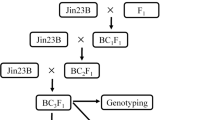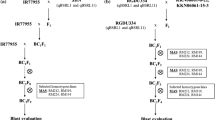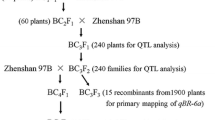Abstract
Rice blast is one of the major fungal diseases that badly reduce rice production in Asia including Malaysia. There is not much information on identification of QTLs as well as linked markers and their association with blast resistance within local rice cultivars. In order to understanding of the genetic control of blast in the F3 families from indica rice cross Pongsu seribu2/Mahsuri, an analysis of quantitative trait loci against one of the highly virulent Malaysian rice blast isolate Magnaporthe oryzae, P5.0 was carried out. Result indicated that partial resistance to this pathotype observed in the present study was controlled by multiple loci or different QTLs. In QTL analysis in F3 progeny fifteen QTLs on chromosomes 1, 2, 3, 5, 6, 11 and 12 for resistance to blast nursery tests was identified. Three of detected QTLs (qRBr-6.1, qRBr-11.4, and qRBr-12.1) had significant threshold (LOD >3) and approved by both IM and CIM methods. Twelve suggestive QTLs, qRBr-1.2, qRBr-2.1, qRBr-4.1, qRBr-5.1, qRBr-6.2, qRBr-6.3, qRBr-8.1, qRBr-10.1, qRBr-10.2, qRBr-11.1, qRBr-11.2 and qRBr-11.3) with Logarithmic of Odds (LOD) <3.0 or LRS <15) were distributed on chromosomes 1, 2, 4, 5, 6, 8, 10, and 11. Most of the QTLs detected using single isolate had the resistant alleles from Pongsu seribu 2 which involved in the resistance in the greenhouse. We found that QTLs detected for deferent traits for the using isolate were frequently located in similar genomic regions. Inheritance study showed among F3 lines resistance segregated in the expected ratio of 15: 1 for resistant to susceptible. The average score for blast resistance measured in the green house was 3.15, 1.98 and 29.95 % for three traits, BLD, BLT and % DLA, respectively.




Similar content being viewed by others
References
Couch BC, Kohn LM (2002) A multilocus gene genealogy concordant with host preference indicates segregation of a new species, Magnaporthe oryzae, from M. grisea. Mycologia 94:683–693
Correa-Victoria F, Zeigler R (1993) Pathogenic variability in Pyricularia grisea at a rice blast hot spot breeding site in eastern Colombia. Plant Dis 77:1029–1035
Ou SH (1985) Rice disease. CABI, Egham, pp 311–315
Rahim HA (2010) Genetic studies on blast disease (Magnaporthe grisea) resistance in Malaysian rice. Dissertation, Universiti Kebangsaan Malaysia
Sharma O, Bambawale O (2008) Integrated management of key diseases of cotton and rice. In: Ciancio A, Mukerji KG (eds) Integrated management of diseases caused by fungi, phytoplasm ad bacteria. Springer, Dordrecht, pp 271–302
Hirano T (1994) Studies on the field resistance of rice varieties to blast disease. Bull Akita Preferential Coll Agric 20:1–41
Tabien R, Li Z, Paterson A, Marchetti M, Stansel J, Pinson S (2002) Mapping QTLs for field resistance to the rice blast pathogen and evaluating their individual and combined utility in improved varieties. Theor Appl Genet 105:313–324
Jia Y, Bryan GT, Farrall L, Valent B (2003) Natural variation at the Pi-ta rice blast resistance locus. Phytopathology 93:1452–1459
Bao J, Zheng X, Xia Y, He P, Shu Q, Lu X, Chen Y, Zhu L (2000) QTL mapping for the paste viscosity characteristics in rice (Oryza sativa L.). Theor Appl Genet 100:280–284
Price A, Steele K, Moore B, Barraclough P, Clark L (2000) A combined RFLP and AFLP linkage map of upland rice (Oryza sativa L.) used to identify QTLs for root-penetration ability. Theor Appl Genet 100:49–56
Sallaud C, Lorieux M, Roumen E, Tharreau D, Berruyer R, Svestasrani P, Garsmeur O, Ghesquière A, Notteghem JL (2003) Identification of five new blast resistance genes in the highly blast-resistant rice variety IR64 using a QTL mapping strategy. Theor Appl Genet 106:794–803
Zenbayashi K, Ashizawa T, Tani T, Koizumi S (2002) Mapping of the QTL (quantitative trait locus) conferring partial resistance to leaf blast in rice cultivar Chubu 32. Theor Appl Genet 104:547–552
Marchetti M (1983) Dilatory resistance to rice blast in USA rice. Phytopathology 73:645–649
Koide Y, Kobayashi N, Xu D, Fukuta Y (2009) Resistance genes and selection DNA markers for blast disease in rice (Oryza sativa L.). Jpn Agric Res Q 43:255–280
Talukder ZI, Tharreau D, Price AH (2004) Quantitative trait loci analysis suggests that partial resistance to rice blast is mostly determined by race–specific interactions. New Phytol 162:197–209
Filippi MC, Prabhu AS (2001) Phenotypic virulence analysis of Pyricularia grisea isolates from Brazilian upland rice cultivars. Pesquisa Agropecuária Brasileira 36:27–35
Chen H (2001) Population structure of Pyricularia grisea from central and southern China and comparative mapping of QTL for blast-and bacterial blight-resistance in rice and barley. Dissertation for Doctoral Degree, Wuhan, Huazhong Agriculture University
IRRI (1996) Standard evaluation system for rice. International Rice Research Institute, Manila
Mackill D, Bonman J (1992) Inheritance of blast resistance in near-isogenic lines of rice. Phytopathology 82:746–749
Gawel N, Jarret R (1991) A modified CTAB DNA extraction procedure for Musa and Ipomoea. Plant Mol Biol Rep 9:262–266
Archak S, Lakshminarayanareddy V, Nagaraju J (2007) High-throughput multiplex microsatellite marker assay for detection and quantification of adulteration in Basmati rice (Oryza sativa). Electrophoresis 28:2396–2405
Manly KF, Cudmore J, R.H., Meer JM (2001) Map Manager QTX, cross-platform software for genetic mapping. Mamm Genome 12:930–932
Meer J, Manly K, Cudmore R (2002) Software for genetic mapping of Mendelian markers and quantitative trait loci. Roswell Park Cancer Institute, Buffalo
Monosi B, Wisser R, Pennill L, Hulbert S (2004) Full-genome analysis of resistance gene homologues in rice. Theor Appl Genet 109:1434–1447
Kosambi D (1943) The estimation of map distances from recombination values. Ann Hum Genet 12:172–175
Haley CS, Knott SA (1992) A simple regression method for mapping quantitative trait loci in line crosses using flanking markers. Heredity 69:315
Yuqing H, Yu Z, Mei S, Guangchun H, Songwen W, Yingguo Z (2001) Studies on the relationship between cultivated and wild rice using ISSR markers [J]. J Agric Biotechnol 2:005
Hittalmani S, Shashidhar H, Bagali PG, Huang N, Sidhu J, Singh V, Khush G (2002) Molecular mapping of quantitative trait loci for plant growth, yield and yield related traits across three diverse locations in a doubled haploid rice population. Euphytica 125:207–214
Zeng ZB (1994) Precision mapping of quantitative trait loci. Genetics 136:1457–1468
Churchill GA, Doerge RW (1994) Empirical threshold values for quantitative trait mapping. Genetics 138:963–971
Wang G, Ding X, Yuan M, Qiu D, Li X, Xu C, Wang S (2006) Dual function of rice OsDR8 gene in disease resistance and thiamine accumulation. Plant Mol Biol 60:437–449
McCouch S, Cho Y, Yano M, Paul E, Blinstrub M, Morishima H, Kinoshita T (1997) Report on QTL nomenclature. Rice Genet Newsl 14:11–13
Tabien R, Li Z, Paterson A, Marchetti M, Stansel J, Pinson S, Park W (2000) Mapping of four major rice blast resistance genes from’Lemont’and’Teqing’and evaluation of their combinatorial effect for field resistance. Theor Appl Genet 101:1215–1225
Cho YC, Kwon SW, Suh JP, Kim JJ, Lee JH, Roh JH, Oh MK, Kim MK, Ahn SN, Koh HJ (2008) QTLs identification and confirmation of field resistance to leaf blast in temperate japonica rice (Oryza sativa L.). J Crop Sci Biotechnol 11:269–276
Chen H, Wang S, Xing Y, Xu C, Hayes PM, Zhang Q (2003) Comparative analyses of genomic locations and race specificities of loci for quantitative resistance to Pyricularia grisea in rice and barley. Proc Natl Acad Sci 100:2544–2549
Lopez-Gerena J (2006) Mapping QTL controlling durable resistance to rice blast in the cultivar Oryzica Llanos 5. Kansas State University, Manhattan
Fjellstrom R, Conaway-Bormans CA, McClung AM, Marchetti MA, Shank AR, Park WD (2004) Development of dna markers suitable for marker assisted selection of three genes conferring Resistance to multiple pathotypes. Crop Sci 44:1790–1798
Haley CS, Andersson L (1997) Linkage mapping of quantitative trait loci in plants and animals. Genome mapping: a practical approach. Oxford University Press, New York, pp 49–71
Tanksley SD (1993) Mapping polygenes. Annu Rev Genet 27:205–233
Acknowledgments
This research activity was funded by Long term Research Grants Scheme (LRGS), Ministry of Higher Education, Malaysia. We would also like to express our sincere thanks to Malaysian Nuclear Agency for providing research facilities. We are also grateful to Malaysian Rice Research Centre, MARDI, Seberang Prai, Penang for supplying pathogen isolates and providing greenhouse facilities.
Author information
Authors and Affiliations
Corresponding author
Electronic supplementary material
Below is the link to the electronic supplementary material.
Rights and permissions
About this article
Cite this article
Ashkani, S., Rafii, M.Y., Rahim, H.A. et al. Genetic dissection of rice blast resistance by QTL mapping approach using an F3 population. Mol Biol Rep 40, 2503–2515 (2013). https://doi.org/10.1007/s11033-012-2331-3
Received:
Accepted:
Published:
Issue Date:
DOI: https://doi.org/10.1007/s11033-012-2331-3




